A Private Tour in North Norfolk today. The request was particularly to look for seaducks, divers and grebes, but there would be time for other birds too. It was cloudy but bright in the morning, but heavy showers were forecast for the afternoon. As it was the weather gods were smiling on us – we sat out one brief shower in the hide at Titchwell and didn’t see another until we were back in the car at the end of the day.
With the target to see some birds on the sea, we started the day at Thornham Harbour with a walk out towards Holme Dunes. As we parked the car, a lone Brent Goose was feeding on the saltmarsh by the road close by. It looked up briefly, but seemed disinterested in our presence.
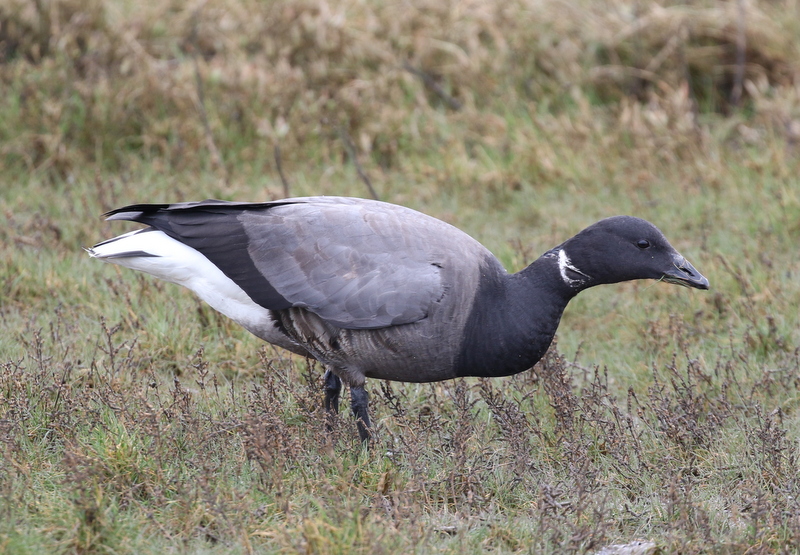 Brent Goose – feeding in the harbour at Thornham
Brent Goose – feeding in the harbour at Thornham
The tide was just going out and the tidal channel was still full of water. From up on the seawall, we could see a few waders on the areas of open mud – Curlew, Grey Plover and Bar-tailed Godwit, as well as several Redshank. The Twite have been rather elusive here this winter, tending to come and go, so it was no surprise that two small birds feeding down on the edge of the saltmarsh were a pair of Linnet.
 Curlew – several were feeding on the mud in the harbour
Curlew – several were feeding on the mud in the harbour
Looking out across the harbour towards the sea, we could see a few ducks diving in the deeper part of the channel in the distance. Through the scope, we could see there were several Red-breasted Mergansers and a couple of female Goldeneye. A Great Crested Grebe was just offshore beyond.
As we walked along the seawall, there were Skylarks singing over the grazing meadows behind us. A couple of Reed Buntings flew out from one of the bushes below the bank, as did a Wren. When two more small birds flitted across the saltmarsh below us, we expected those to be Linnets again, but a quick look revealed they were Twite. Through the scope, we could see their yellow bills and orange-washed breasts. They fed for a time in the vegetation on the edge of the mud, before eventually disappearing off back into the saltmarsh.
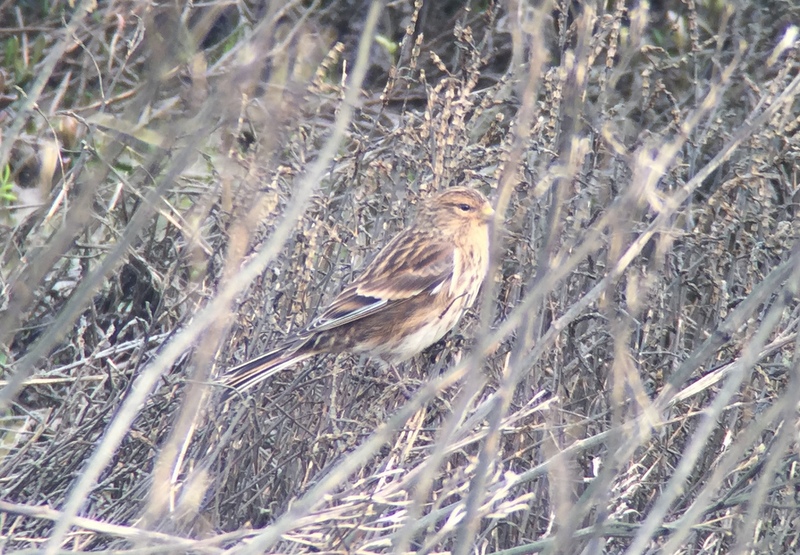 Twite – we found a pair on the saltmarsh on our walk out
Twite – we found a pair on the saltmarsh on our walk out
Six geese flying in from the east over the harbour were Pink-footed Geese. We heard them calling and watched as they dropped down towards the grazing marshes to the west. Looking across, we could see a large flock of geese already down on the grass. Through the scope, we could see that the vast majority were Pink-footed Geese too. But then a head came up with a distinctive white surround to the base of the bill – two White-fronted Geese were hiding in with the Pinkfeet.
A shrill call high overhead alerted us to a displaying Marsh Harrier, a male, flying up and down with exaggerated, flappy wingbeats. Two more Marsh Harriers, females, flew in over the saltmarsh and, behind us, another two circled up over the grazing marshes. The bright conditions were obviously encouraging a burst of Marsh Harrier display activity this morning.
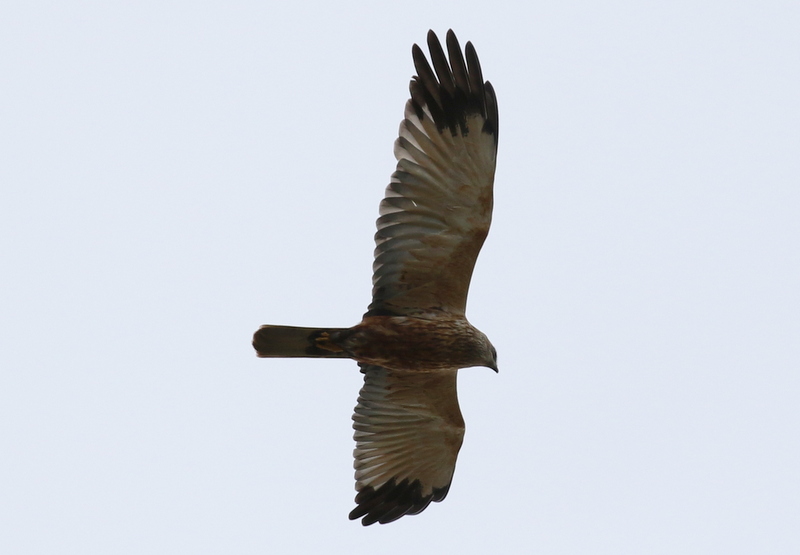 Marsh Harrier – this male was displaying overhead
Marsh Harrier – this male was displaying overhead
A quick look out across Broadwater from the edge of the dunes added Tufted Duck and Common Pochard to the day’s list. A few Mallard and a pair of Shoveler were lurking in the reeds. A few Greylag Geese and a big flock of Curlew were in the fields beyond.
From the top of the dunes, we set ourselves up to scan the sea. Almost the first bird we set eyes on was a Great Northern Diver. It was not far offshore, but diving regularly and drifting east. It was clearly big and we got it in the scope and could see the contrast between the blackish upperparts and white throat and breast, with a black half collar.
Scanning the sea, we could see several Red-breasted Mergansers out on the water. Five large, heavy ducks flying in from the east were Eider – three all dark females and two 1st winter drakes, with contrasting white breasts. They landed on the sea further out where we could see them distantly. A little later, we looked back and found two smart drake Eider in the same area. There were a couple of Common Scoter out here too today, a blackish drake and a pale-cheeked female.
The Long-tailed Ducks have become more elusive in recent days. It is possible they have already started to move back north, although they may just have moved further offshore. Fortunately a few obliged us by flying in this morning. First, we picked up a lone Long-tailed Duck flying in from way out to sea, but it turned east and eventually landed some way away, off Thornham Point. We could just make it out through the scope. Then a pair flew in and landed out beyond the Red-breasted Mergansers. They were still distant, but we could see there was a smart male and browner female. The fourth Long-tailed Duck, a female, was even more obliging, and landed with the mergansers where we could get a much better view of it. To round out the total, a fifth flew past a little later.
While we were looking through the ducks, we picked up a Slavonian Grebe on the sea. It was clearly small, next to the Red-breasted Mergansers. It had a flat crown, white cheeks and a neatly defined black cap. Red-throated Diver is the most regular diver species here and we found one or two out on the sea. Black-throated Diver is the rarest so it was a bonus to find one just as we were about to call it a day. We were alerted to it by a flash of its white flank patch as it dived. It was rather distant, but when it surfaced again we could also see its very contrasting black and white colouration, and sleeker, slimmer structure compared to the Great Northern Diver we had seen earlier.
After such a fantastically productive morning here, we decided to head back to the car. Three species of diver and an excellent selection of seaduck was a great return for our efforts. A Little Grebe on Broadwater on the way back made it three species of grebe for the site today too!
As we walked back along the seawall, we could hear Twite calling. We assumed it would just be the pair we had seen earlier, but a flock of around 25 Twite flew up from the saltmarsh and across the path in front of us. A couple of males flashed bright pink rumps as they flew past. They dropped down by a pool on the grazing marsh for a quick drink, before flying back to the saltmarsh again. We had another good look at them through the scope.
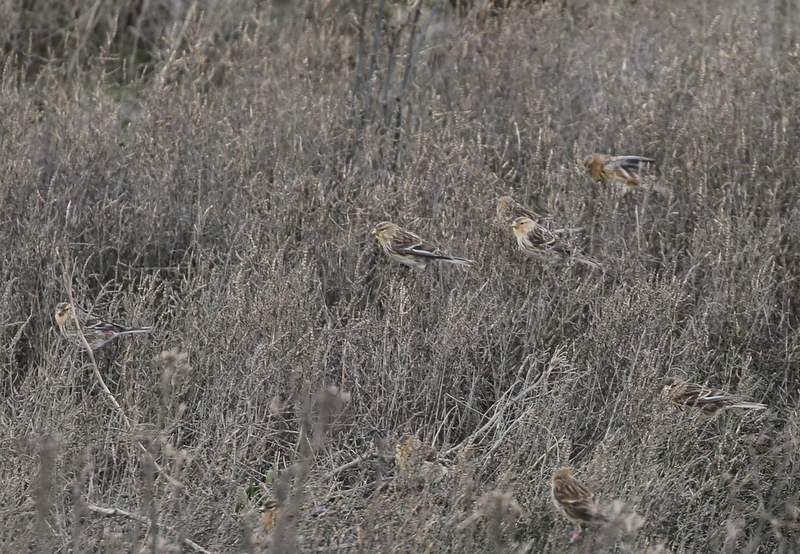 Twite – a flock of about 25 had appeared on the walk back
Twite – a flock of about 25 had appeared on the walk back
There had been a Glaucous Gull reported by some pig fields inland from here yesterday, so we decided to have a quick drive round to see if we could find it. We did find a large flock of gulls loafing in a field by an irrigation reservoir, but all we could see there were Black-headed, Common and Herring Gulls. There didn’t appear to be many gulls around the pig fields today.
The buntings were more obliging. There has been a big flock of Yellowhammers here through the winter and there must have been at least 60 here still today. Several were bathing in a puddle as we arrived, including some stunningly yellow males. They were rather flighty, constantly flying between the hedges and the field the other side. However, when they perched up in the hedge we could get a good look at them.
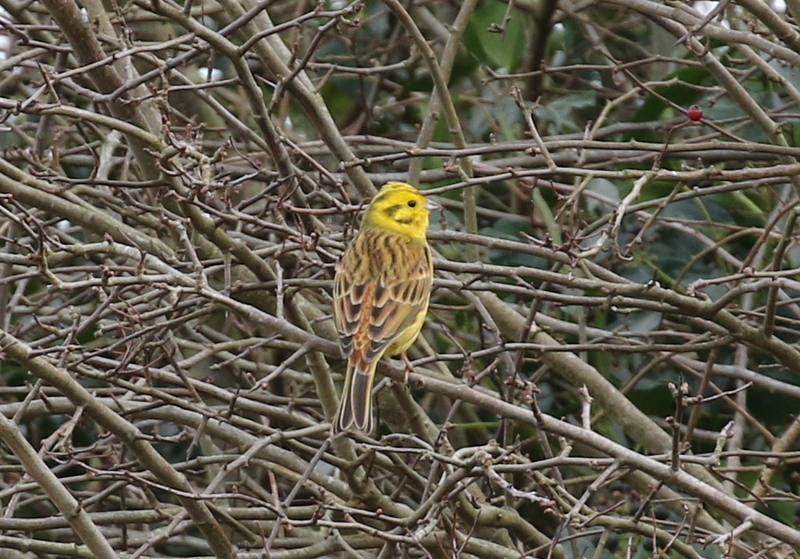 Yellowhammer – at least 60 in the flock today
Yellowhammer – at least 60 in the flock today
As well as the Yellowhammers, there have been good numbers of Corn Bunting here and there were still at least 6 here today.We could hear one singing when we got out of the car, the song often compared to jangling keys, but we couldn’t see it through the hedge. Then one flew over as we walked along the road, we were alerted to it by its distinctive liquid ‘pit’ call. Finally we managed to get three in the scope, perched up together in the top of a small tree. They are getting so scarce now, it is always a delight to see Corn Buntings.
There were other things to see here too. There were several Reed Buntings in with the Yellowhammers and Corn Buntings. A pair of Stock Doves were feeding in a recently sown field, much more delicate birds then the similarly grey Woodpigeon. A couple of Red Kites hung in the air over a nearby wood. When a Kestrel flew over the field, all the Yellowhammers and Corn Buntings scattered.
Our destination for the afternoon was Titchwell. After lunch by the visitor centre and a welcome hot drink, we made had a look at the feeders. There were a few Greenfinches with the Chaffinches and Goldfinches, but the highlight was a couple of female Bramblings which dropped in to join them. The Water Rail was in the ditch by the main path as usual, but was lurking under a tangle of vegetation bathing today.
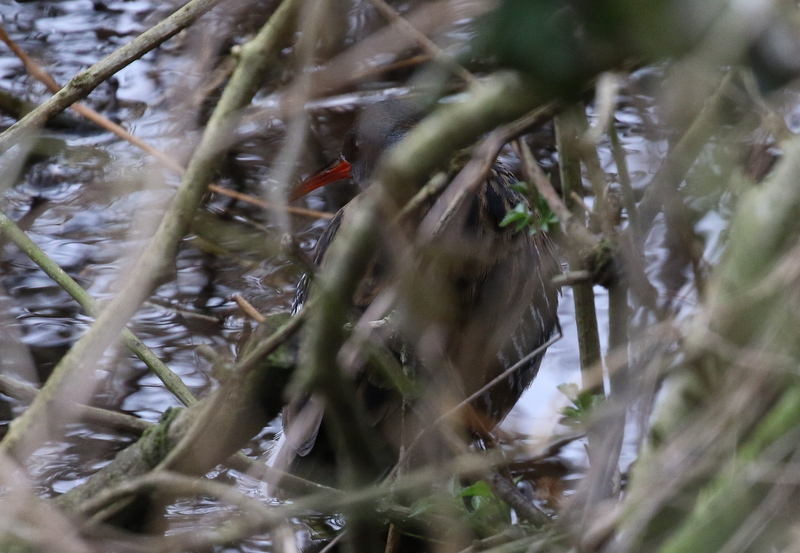 Water Rail – lurking under a tangle of vegetation bathing
Water Rail – lurking under a tangle of vegetation bathing
The dried out grazing meadow ‘pool’ looked devoid of life at first. We repositioned ourselves further along the path, so we could see round behind the reeds at the front. At that point, one of the group spotted a bird right down at the front – the Water Pipit we had been looking for. We had a great view of it through the scope, noting its white underparts neatly streaked with black, and well-marked white supercilium.
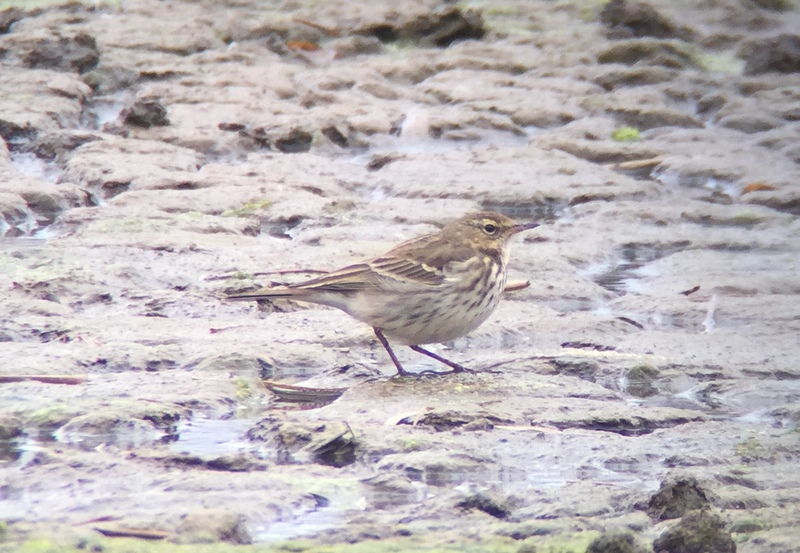 Water Pipit – showed very well on the grazing meadow ‘pool’
Water Pipit – showed very well on the grazing meadow ‘pool’
A single Great Crested Grebe was at the back of the reedbed pool, asleep amongst the ducks. While we were scanning around the edges of the pool, a small wader flicked up and dropped down on a patch of cut reed at the front. We had a very restricted view, with a line of reeds in front. Looking through with the scope we managed to see there was a Common Snipe feeding there, but the bird we had just seen fly in was smaller than that. Then, just behind it, we caught sight of a Jack Snipe.
The Jack Snipe flew across the water at the front and landed on another patch of cut reed the other side, out of view. By walking a little further along the path and looking back, we were able to find it again, though we still had to look through the reeds in the front. It was very well camouflaged, with its bright golden mantle stripes in amongst the reed stems, but the Jack Snipe was feeding with its distinctive bobbing action. Great to watch!
We could see dark clouds approaching from the west, so we made our way quickly round to Parrinder Hide to scan the Freshmarsh from there. As we walked round, a huge flock of Golden Plover flew up from the fenced off island and most of them seemed to drift off inland. We got into the hide just in time, as a squally shower blew in.
There is still a good variety of ducks on the Freshmarsh at the moment – Wigeon, Gadwall, Teal and Shoveler. The birds huddled up against the rain. There were also good numbers of gulls again, but we couldn’t find anything other than Black-headed Gull, Common Gull and Herring Gull on here today.
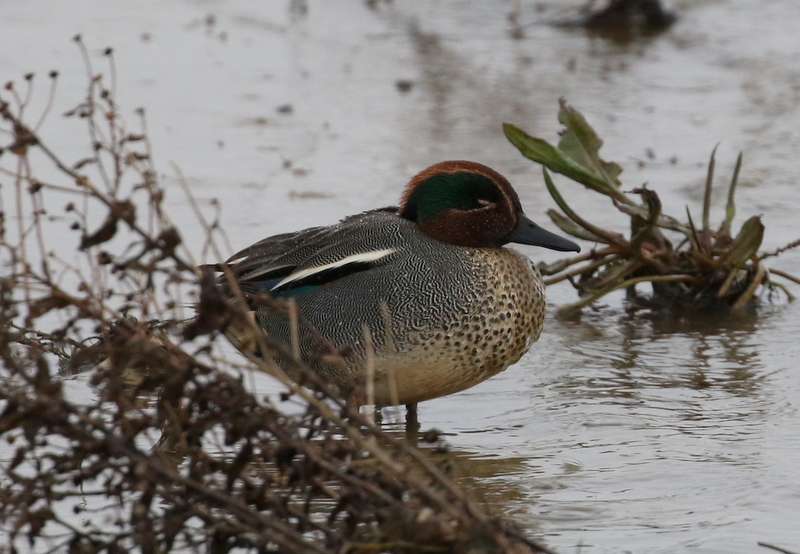 Teal – a smart drake, huddled up facing into the rain
Teal – a smart drake, huddled up facing into the rain
There were lots of Redshank in particular on the Freshmarsh today. Perhaps they had been flushed off the Volunteer Marsh by something? Several Knot flew in too and landed in with the gulls. A noisy little group of Oystercatcher were gathered in a circle giving a piping display. There were also lots of Avocet on here – numbers are continuing to increase as birds return after the winter. A colour-ringed Black-tailed Godwit stood pointing into the rain.
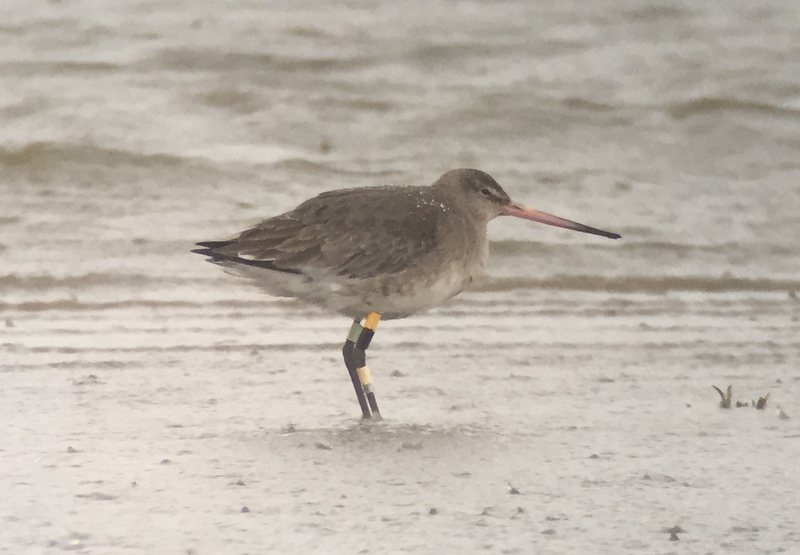 Black-tailed Godwit – a colour-ringed bird in the rain
Black-tailed Godwit – a colour-ringed bird in the rain
Thankfully the rain blew through quickly. Once it stopped, we made our way round to the other side of Parrinder Hide, overlooking the Volunteer Marsh. There were several Knot, Grey Plover and Curlew on the mud in front of the hide when we walked in, but almost immediately something flushed all the birds and the waders all flew off. The Redshanks had gone over to join the others on the Freshmarsh – we could see them all busy bathing and preening from the window at the back of the hide.
As it was starting to brighten up again, we decided to make a bid for the beach. From round on the main path, we stopped to watch a couple of Knot and a couple of Dunlin which dropped back in together on the mud, a nice chance to compare the two species.
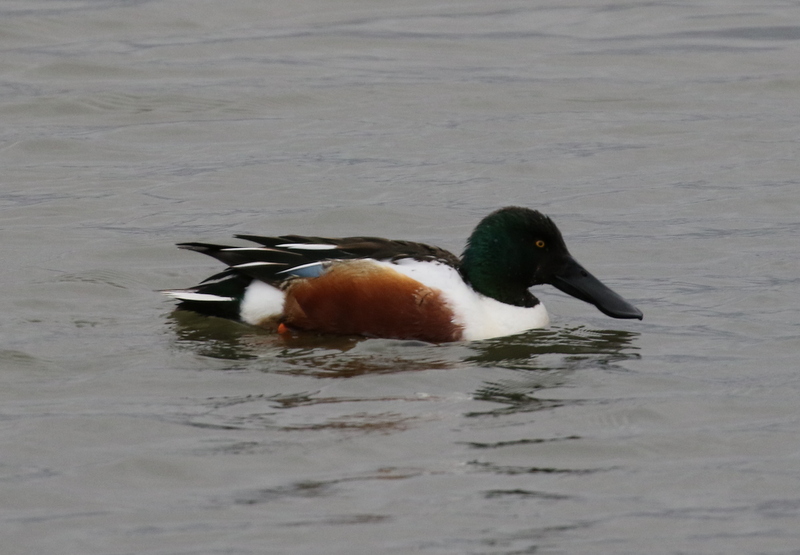 Shoveler – several were out on the Tidal Pools
Shoveler – several were out on the Tidal Pools
The Pintail were all out on the Tidal Pools today, along with more Shoveler and Mallard. There were also a few waders on here, in particular several Black-tailed and Bar-tailed Godwits. This provided a good opportunity to compare the two species – the Bar-tailed Godwit being obviously smaller, shorter-legged and with paler, buffier upperparts streaked with dark.
The tide was coming in again out at the beach. Large groups of Oystercatcher and Bar-tailed Godwit were gathered along the shoreline. There was quite a lot of seaweed scattered across the sand today and we could see several silvery Sanderling feeding in amongst it.
There was a flock of Scoter further offshore and through the scope we could see they were mostly Velvet Scoter with a smaller number of Common Scoter in with them. Even better, a single Velvet Scoter was much closer in and we could see the distinctive twin smaller white spots on its face. A couple of Common Scoter were closer in too, and when it turned head on, we could see the yellow stripe down the top of the bill on the drake. Otherwise, the sea here was much quieter than it had been at Holme this morning – just a few Red-breasted Merganser and Goldeneye. Still, Velvet Scoter was a nice bird to round out the set of our seaduck for the day.
As we made our way back along the main path, we stopped for another look at the Jack Snipe. There were now two Common Snipe on the same side of the pool as the Jack Snipe, we could see their pale central crown stripes. The Common Snipe were out in the middle of the patch of cut reed, but typically the Jack Snipe was more secretive, still keeping nearer to cover at the edge of the tall reeds. However, it had worked its way out to the edge of a little puddle where we could see it better, its shorter bill and dark central crown.
 Jack Snipe – feeding on the edge of the reedbed pool
Jack Snipe – feeding on the edge of the reedbed pool
On the way back, we cut round via Meadow Trail and out to Patsy’s Reedbed. The water level is being kept high on here this year – attractive for the Tufted Ducks, Common Pochard and Coot which were all diving on here. Several Marsh Harriers were starting to gather over the reedbed, ahead of going to roost. A Cetti’s Warbler sand from the bushes.
The afternoon was getting on and it was starting to get dark, but when we turned to look behind us we could see another bank of dark clouds approaching from the west, so we decided to make our way back. We had heard Bullfinches calling on the way out and seen a couple of shapes disappearing off into the bushes. On the way back, they were more helpfully feeding in the top of a small tree, picking at the buds. The three females were perched in full view, while the pink male lurked a little further back. A couple of Jays called noisily from the sallows and we flushed a Muntjac from beside the boardwalk, which scuttled off into the undergrowth.
We got back to the car just in time, as a wintry shower blew through. We had been remarkably lucky with the weather today and we didn’t mind a bit of rain now we were on our way home.
















